Education Support Assignment: Barriers, Multilingualism, and Culture
VerifiedAdded on 2022/09/18
|7
|1599
|26
Homework Assignment
AI Summary
This assignment explores various aspects of supporting Aboriginal students in an educational setting. Part A addresses barriers to education, defines multilingualism, and outlines the role of an education support worker in assisting multilingual students. Part B delves into research on the Binjari community, examining their language, unique cultural aspects, and the importance of local community awareness in education. The assignment also analyzes a poem related to the Stolen Generation, discusses the impact of historical issues on Aboriginal health and education, and proposes an activity to promote health awareness. The student emphasizes the importance of inclusive education and preserving Aboriginal culture and language.
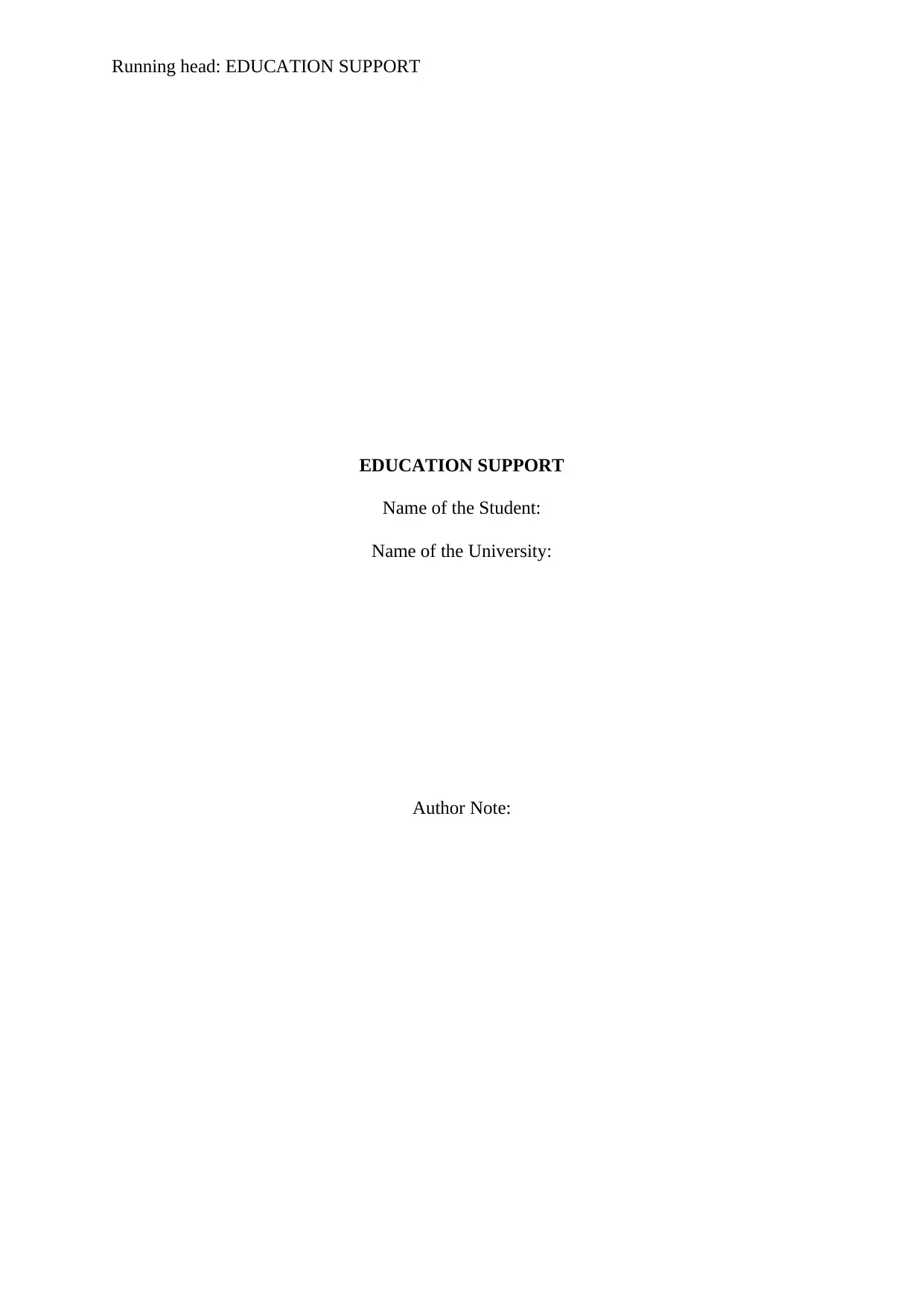
Running head: EDUCATION SUPPORT
EDUCATION SUPPORT
Name of the Student:
Name of the University:
Author Note:
EDUCATION SUPPORT
Name of the Student:
Name of the University:
Author Note:
Paraphrase This Document
Need a fresh take? Get an instant paraphrase of this document with our AI Paraphraser
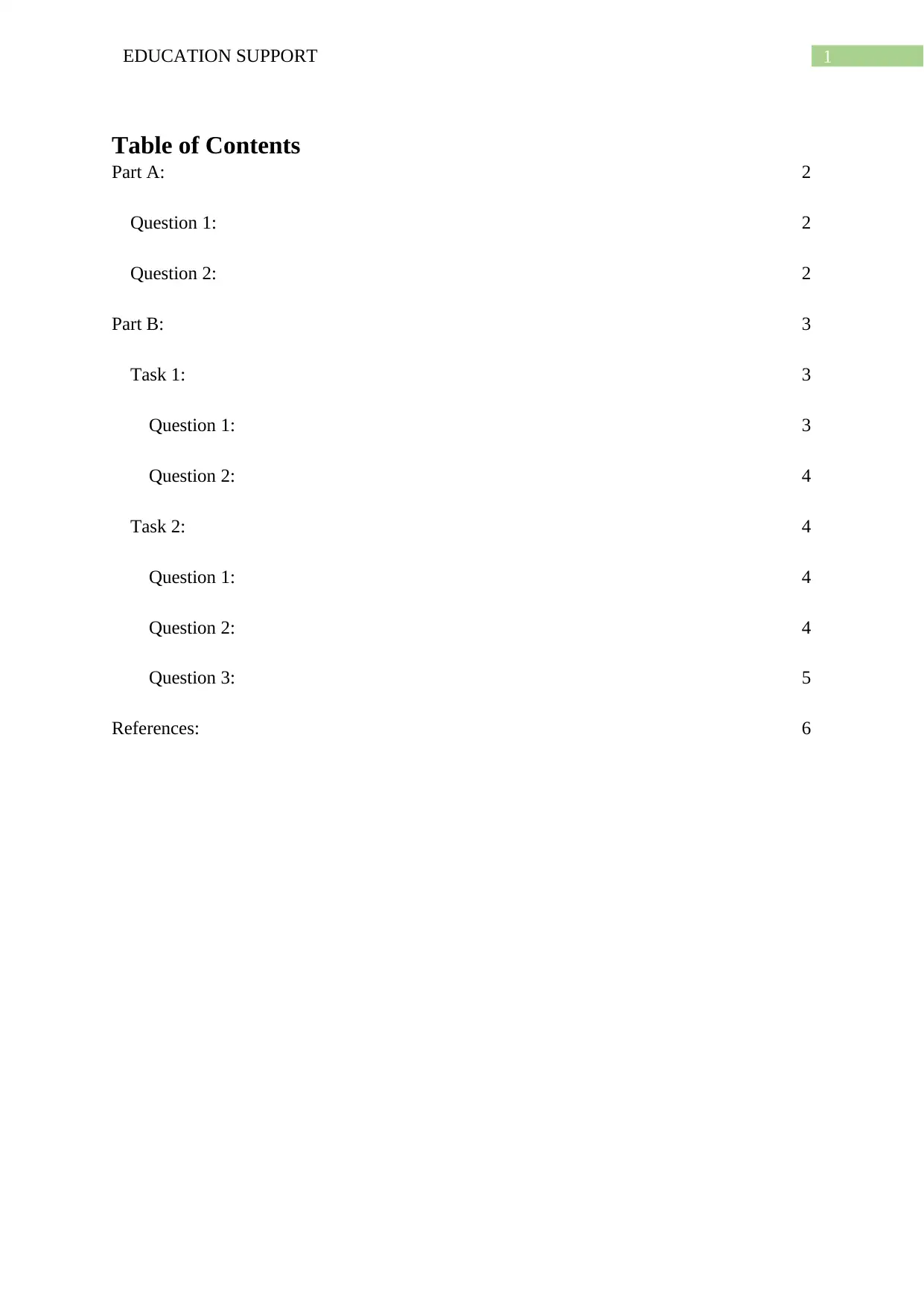
1EDUCATION SUPPORT
Table of Contents
Part A: 2
Question 1: 2
Question 2: 2
Part B: 3
Task 1: 3
Question 1: 3
Question 2: 4
Task 2: 4
Question 1: 4
Question 2: 4
Question 3: 5
References: 6
Table of Contents
Part A: 2
Question 1: 2
Question 2: 2
Part B: 3
Task 1: 3
Question 1: 3
Question 2: 4
Task 2: 4
Question 1: 4
Question 2: 4
Question 3: 5
References: 6
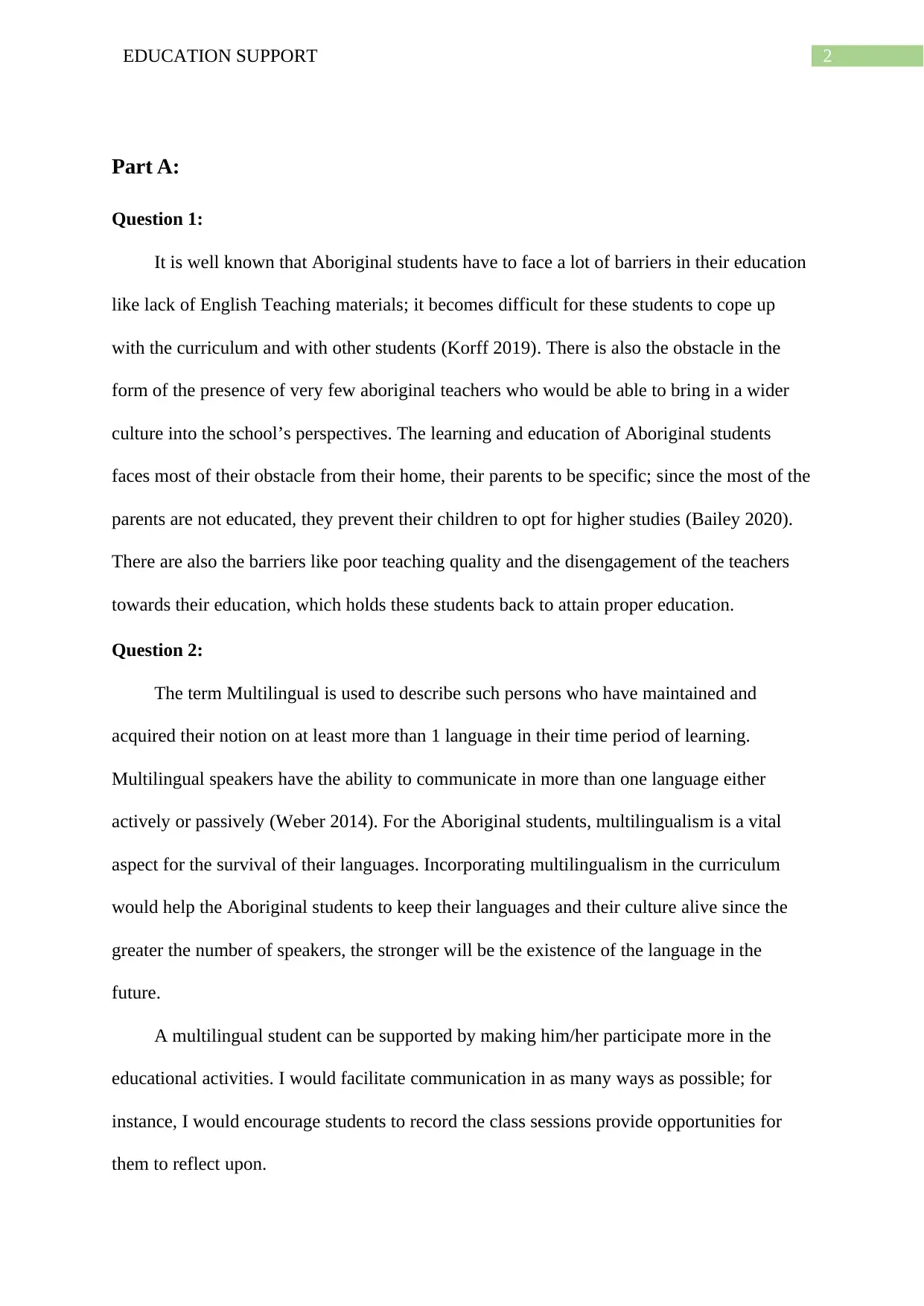
2EDUCATION SUPPORT
Part A:
Question 1:
It is well known that Aboriginal students have to face a lot of barriers in their education
like lack of English Teaching materials; it becomes difficult for these students to cope up
with the curriculum and with other students (Korff 2019). There is also the obstacle in the
form of the presence of very few aboriginal teachers who would be able to bring in a wider
culture into the school’s perspectives. The learning and education of Aboriginal students
faces most of their obstacle from their home, their parents to be specific; since the most of the
parents are not educated, they prevent their children to opt for higher studies (Bailey 2020).
There are also the barriers like poor teaching quality and the disengagement of the teachers
towards their education, which holds these students back to attain proper education.
Question 2:
The term Multilingual is used to describe such persons who have maintained and
acquired their notion on at least more than 1 language in their time period of learning.
Multilingual speakers have the ability to communicate in more than one language either
actively or passively (Weber 2014). For the Aboriginal students, multilingualism is a vital
aspect for the survival of their languages. Incorporating multilingualism in the curriculum
would help the Aboriginal students to keep their languages and their culture alive since the
greater the number of speakers, the stronger will be the existence of the language in the
future.
A multilingual student can be supported by making him/her participate more in the
educational activities. I would facilitate communication in as many ways as possible; for
instance, I would encourage students to record the class sessions provide opportunities for
them to reflect upon.
Part A:
Question 1:
It is well known that Aboriginal students have to face a lot of barriers in their education
like lack of English Teaching materials; it becomes difficult for these students to cope up
with the curriculum and with other students (Korff 2019). There is also the obstacle in the
form of the presence of very few aboriginal teachers who would be able to bring in a wider
culture into the school’s perspectives. The learning and education of Aboriginal students
faces most of their obstacle from their home, their parents to be specific; since the most of the
parents are not educated, they prevent their children to opt for higher studies (Bailey 2020).
There are also the barriers like poor teaching quality and the disengagement of the teachers
towards their education, which holds these students back to attain proper education.
Question 2:
The term Multilingual is used to describe such persons who have maintained and
acquired their notion on at least more than 1 language in their time period of learning.
Multilingual speakers have the ability to communicate in more than one language either
actively or passively (Weber 2014). For the Aboriginal students, multilingualism is a vital
aspect for the survival of their languages. Incorporating multilingualism in the curriculum
would help the Aboriginal students to keep their languages and their culture alive since the
greater the number of speakers, the stronger will be the existence of the language in the
future.
A multilingual student can be supported by making him/her participate more in the
educational activities. I would facilitate communication in as many ways as possible; for
instance, I would encourage students to record the class sessions provide opportunities for
them to reflect upon.
⊘ This is a preview!⊘
Do you want full access?
Subscribe today to unlock all pages.

Trusted by 1+ million students worldwide
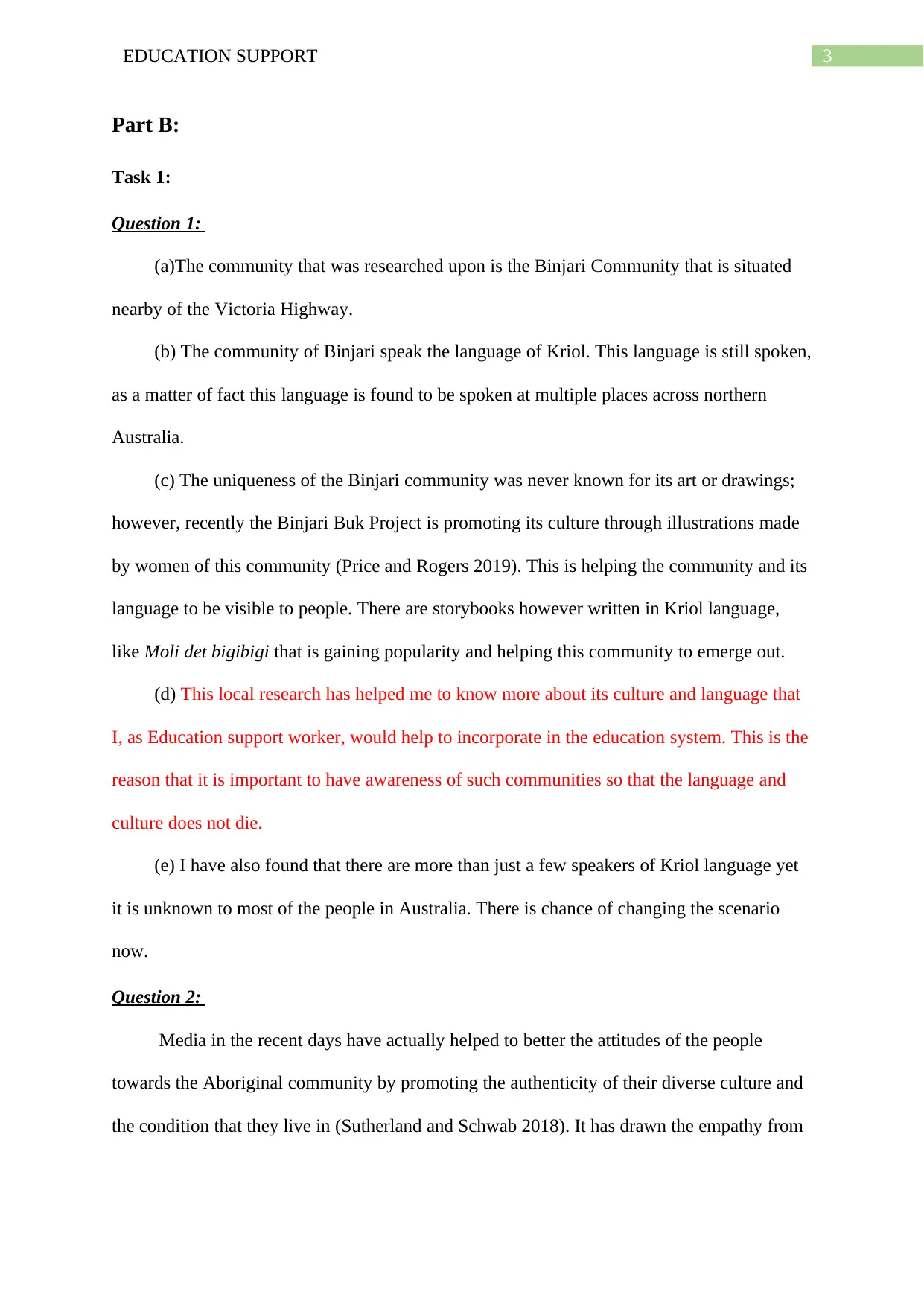
3EDUCATION SUPPORT
Part B:
Task 1:
Question 1:
(a)The community that was researched upon is the Binjari Community that is situated
nearby of the Victoria Highway.
(b) The community of Binjari speak the language of Kriol. This language is still spoken,
as a matter of fact this language is found to be spoken at multiple places across northern
Australia.
(c) The uniqueness of the Binjari community was never known for its art or drawings;
however, recently the Binjari Buk Project is promoting its culture through illustrations made
by women of this community (Price and Rogers 2019). This is helping the community and its
language to be visible to people. There are storybooks however written in Kriol language,
like Moli det bigibigi that is gaining popularity and helping this community to emerge out.
(d) This local research has helped me to know more about its culture and language that
I, as Education support worker, would help to incorporate in the education system. This is the
reason that it is important to have awareness of such communities so that the language and
culture does not die.
(e) I have also found that there are more than just a few speakers of Kriol language yet
it is unknown to most of the people in Australia. There is chance of changing the scenario
now.
Question 2:
Media in the recent days have actually helped to better the attitudes of the people
towards the Aboriginal community by promoting the authenticity of their diverse culture and
the condition that they live in (Sutherland and Schwab 2018). It has drawn the empathy from
Part B:
Task 1:
Question 1:
(a)The community that was researched upon is the Binjari Community that is situated
nearby of the Victoria Highway.
(b) The community of Binjari speak the language of Kriol. This language is still spoken,
as a matter of fact this language is found to be spoken at multiple places across northern
Australia.
(c) The uniqueness of the Binjari community was never known for its art or drawings;
however, recently the Binjari Buk Project is promoting its culture through illustrations made
by women of this community (Price and Rogers 2019). This is helping the community and its
language to be visible to people. There are storybooks however written in Kriol language,
like Moli det bigibigi that is gaining popularity and helping this community to emerge out.
(d) This local research has helped me to know more about its culture and language that
I, as Education support worker, would help to incorporate in the education system. This is the
reason that it is important to have awareness of such communities so that the language and
culture does not die.
(e) I have also found that there are more than just a few speakers of Kriol language yet
it is unknown to most of the people in Australia. There is chance of changing the scenario
now.
Question 2:
Media in the recent days have actually helped to better the attitudes of the people
towards the Aboriginal community by promoting the authenticity of their diverse culture and
the condition that they live in (Sutherland and Schwab 2018). It has drawn the empathy from
Paraphrase This Document
Need a fresh take? Get an instant paraphrase of this document with our AI Paraphraser
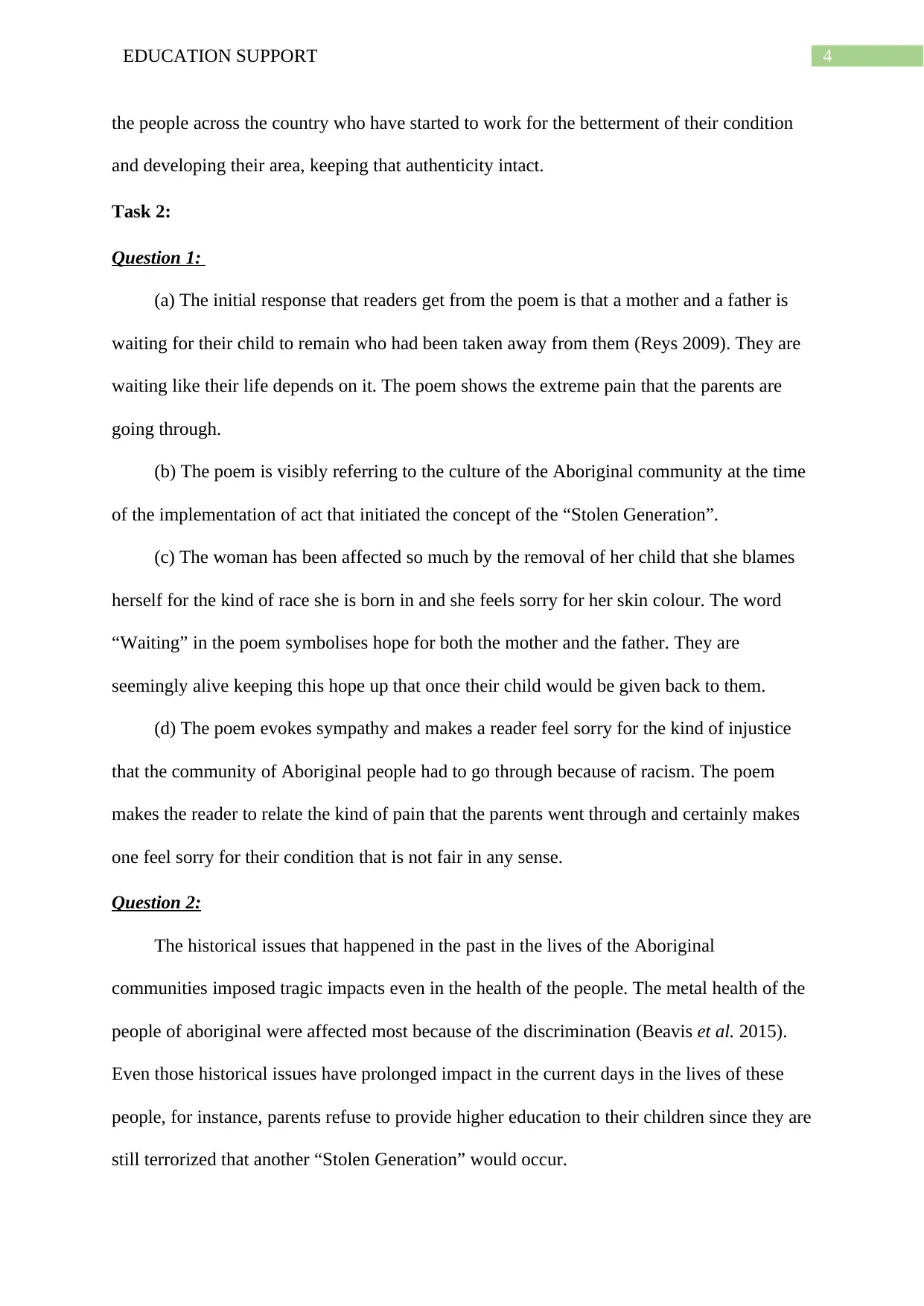
4EDUCATION SUPPORT
the people across the country who have started to work for the betterment of their condition
and developing their area, keeping that authenticity intact.
Task 2:
Question 1:
(a) The initial response that readers get from the poem is that a mother and a father is
waiting for their child to remain who had been taken away from them (Reys 2009). They are
waiting like their life depends on it. The poem shows the extreme pain that the parents are
going through.
(b) The poem is visibly referring to the culture of the Aboriginal community at the time
of the implementation of act that initiated the concept of the “Stolen Generation”.
(c) The woman has been affected so much by the removal of her child that she blames
herself for the kind of race she is born in and she feels sorry for her skin colour. The word
“Waiting” in the poem symbolises hope for both the mother and the father. They are
seemingly alive keeping this hope up that once their child would be given back to them.
(d) The poem evokes sympathy and makes a reader feel sorry for the kind of injustice
that the community of Aboriginal people had to go through because of racism. The poem
makes the reader to relate the kind of pain that the parents went through and certainly makes
one feel sorry for their condition that is not fair in any sense.
Question 2:
The historical issues that happened in the past in the lives of the Aboriginal
communities imposed tragic impacts even in the health of the people. The metal health of the
people of aboriginal were affected most because of the discrimination (Beavis et al. 2015).
Even those historical issues have prolonged impact in the current days in the lives of these
people, for instance, parents refuse to provide higher education to their children since they are
still terrorized that another “Stolen Generation” would occur.
the people across the country who have started to work for the betterment of their condition
and developing their area, keeping that authenticity intact.
Task 2:
Question 1:
(a) The initial response that readers get from the poem is that a mother and a father is
waiting for their child to remain who had been taken away from them (Reys 2009). They are
waiting like their life depends on it. The poem shows the extreme pain that the parents are
going through.
(b) The poem is visibly referring to the culture of the Aboriginal community at the time
of the implementation of act that initiated the concept of the “Stolen Generation”.
(c) The woman has been affected so much by the removal of her child that she blames
herself for the kind of race she is born in and she feels sorry for her skin colour. The word
“Waiting” in the poem symbolises hope for both the mother and the father. They are
seemingly alive keeping this hope up that once their child would be given back to them.
(d) The poem evokes sympathy and makes a reader feel sorry for the kind of injustice
that the community of Aboriginal people had to go through because of racism. The poem
makes the reader to relate the kind of pain that the parents went through and certainly makes
one feel sorry for their condition that is not fair in any sense.
Question 2:
The historical issues that happened in the past in the lives of the Aboriginal
communities imposed tragic impacts even in the health of the people. The metal health of the
people of aboriginal were affected most because of the discrimination (Beavis et al. 2015).
Even those historical issues have prolonged impact in the current days in the lives of these
people, for instance, parents refuse to provide higher education to their children since they are
still terrorized that another “Stolen Generation” would occur.
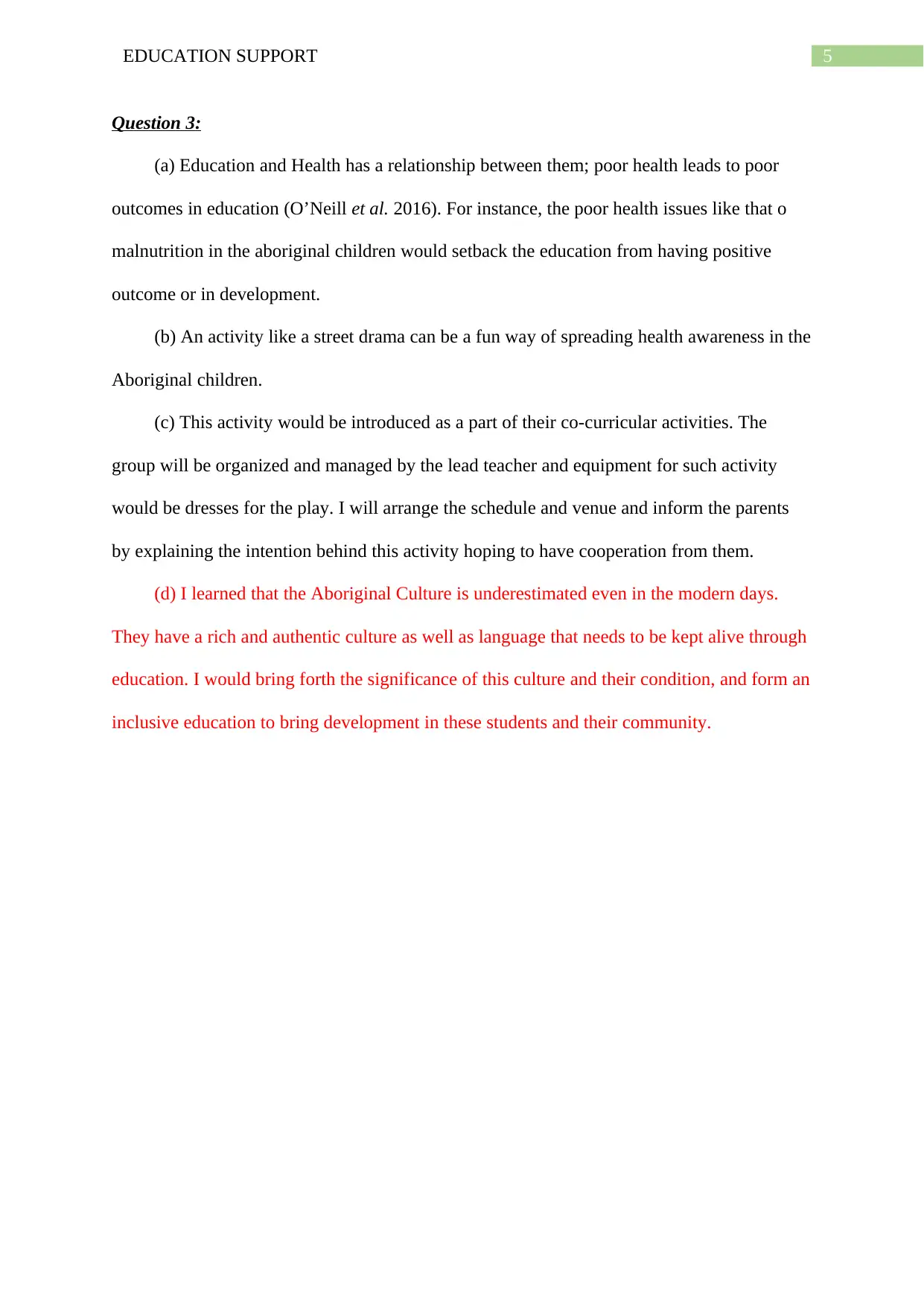
5EDUCATION SUPPORT
Question 3:
(a) Education and Health has a relationship between them; poor health leads to poor
outcomes in education (O’Neill et al. 2016). For instance, the poor health issues like that o
malnutrition in the aboriginal children would setback the education from having positive
outcome or in development.
(b) An activity like a street drama can be a fun way of spreading health awareness in the
Aboriginal children.
(c) This activity would be introduced as a part of their co-curricular activities. The
group will be organized and managed by the lead teacher and equipment for such activity
would be dresses for the play. I will arrange the schedule and venue and inform the parents
by explaining the intention behind this activity hoping to have cooperation from them.
(d) I learned that the Aboriginal Culture is underestimated even in the modern days.
They have a rich and authentic culture as well as language that needs to be kept alive through
education. I would bring forth the significance of this culture and their condition, and form an
inclusive education to bring development in these students and their community.
Question 3:
(a) Education and Health has a relationship between them; poor health leads to poor
outcomes in education (O’Neill et al. 2016). For instance, the poor health issues like that o
malnutrition in the aboriginal children would setback the education from having positive
outcome or in development.
(b) An activity like a street drama can be a fun way of spreading health awareness in the
Aboriginal children.
(c) This activity would be introduced as a part of their co-curricular activities. The
group will be organized and managed by the lead teacher and equipment for such activity
would be dresses for the play. I will arrange the schedule and venue and inform the parents
by explaining the intention behind this activity hoping to have cooperation from them.
(d) I learned that the Aboriginal Culture is underestimated even in the modern days.
They have a rich and authentic culture as well as language that needs to be kept alive through
education. I would bring forth the significance of this culture and their condition, and form an
inclusive education to bring development in these students and their community.
⊘ This is a preview!⊘
Do you want full access?
Subscribe today to unlock all pages.

Trusted by 1+ million students worldwide
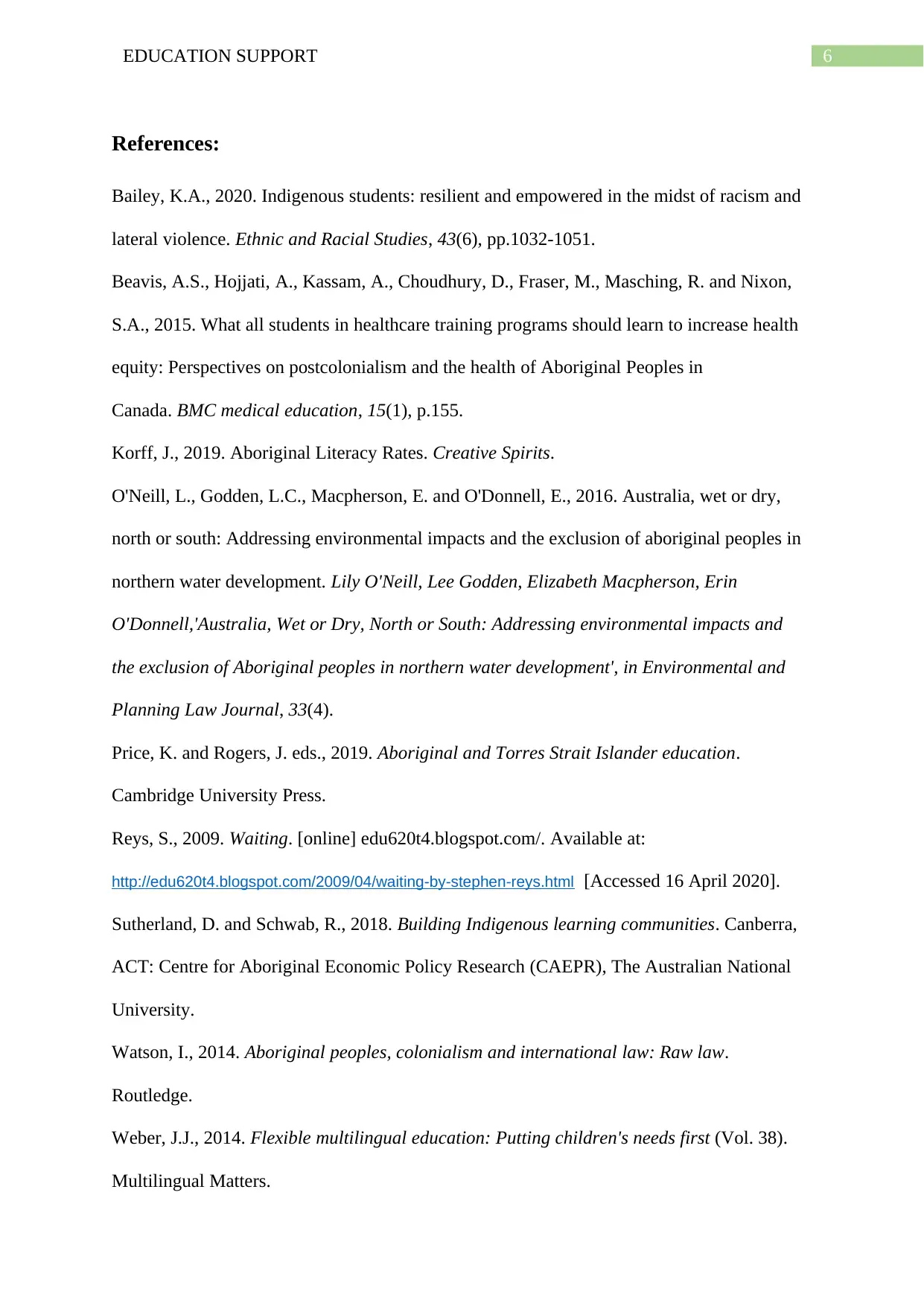
6EDUCATION SUPPORT
References:
Bailey, K.A., 2020. Indigenous students: resilient and empowered in the midst of racism and
lateral violence. Ethnic and Racial Studies, 43(6), pp.1032-1051.
Beavis, A.S., Hojjati, A., Kassam, A., Choudhury, D., Fraser, M., Masching, R. and Nixon,
S.A., 2015. What all students in healthcare training programs should learn to increase health
equity: Perspectives on postcolonialism and the health of Aboriginal Peoples in
Canada. BMC medical education, 15(1), p.155.
Korff, J., 2019. Aboriginal Literacy Rates. Creative Spirits.
O'Neill, L., Godden, L.C., Macpherson, E. and O'Donnell, E., 2016. Australia, wet or dry,
north or south: Addressing environmental impacts and the exclusion of aboriginal peoples in
northern water development. Lily O'Neill, Lee Godden, Elizabeth Macpherson, Erin
O'Donnell,'Australia, Wet or Dry, North or South: Addressing environmental impacts and
the exclusion of Aboriginal peoples in northern water development', in Environmental and
Planning Law Journal, 33(4).
Price, K. and Rogers, J. eds., 2019. Aboriginal and Torres Strait Islander education.
Cambridge University Press.
Reys, S., 2009. Waiting. [online] edu620t4.blogspot.com/. Available at:
http://edu620t4.blogspot.com/2009/04/waiting-by-stephen-reys.html [Accessed 16 April 2020].
Sutherland, D. and Schwab, R., 2018. Building Indigenous learning communities. Canberra,
ACT: Centre for Aboriginal Economic Policy Research (CAEPR), The Australian National
University.
Watson, I., 2014. Aboriginal peoples, colonialism and international law: Raw law.
Routledge.
Weber, J.J., 2014. Flexible multilingual education: Putting children's needs first (Vol. 38).
Multilingual Matters.
References:
Bailey, K.A., 2020. Indigenous students: resilient and empowered in the midst of racism and
lateral violence. Ethnic and Racial Studies, 43(6), pp.1032-1051.
Beavis, A.S., Hojjati, A., Kassam, A., Choudhury, D., Fraser, M., Masching, R. and Nixon,
S.A., 2015. What all students in healthcare training programs should learn to increase health
equity: Perspectives on postcolonialism and the health of Aboriginal Peoples in
Canada. BMC medical education, 15(1), p.155.
Korff, J., 2019. Aboriginal Literacy Rates. Creative Spirits.
O'Neill, L., Godden, L.C., Macpherson, E. and O'Donnell, E., 2016. Australia, wet or dry,
north or south: Addressing environmental impacts and the exclusion of aboriginal peoples in
northern water development. Lily O'Neill, Lee Godden, Elizabeth Macpherson, Erin
O'Donnell,'Australia, Wet or Dry, North or South: Addressing environmental impacts and
the exclusion of Aboriginal peoples in northern water development', in Environmental and
Planning Law Journal, 33(4).
Price, K. and Rogers, J. eds., 2019. Aboriginal and Torres Strait Islander education.
Cambridge University Press.
Reys, S., 2009. Waiting. [online] edu620t4.blogspot.com/. Available at:
http://edu620t4.blogspot.com/2009/04/waiting-by-stephen-reys.html [Accessed 16 April 2020].
Sutherland, D. and Schwab, R., 2018. Building Indigenous learning communities. Canberra,
ACT: Centre for Aboriginal Economic Policy Research (CAEPR), The Australian National
University.
Watson, I., 2014. Aboriginal peoples, colonialism and international law: Raw law.
Routledge.
Weber, J.J., 2014. Flexible multilingual education: Putting children's needs first (Vol. 38).
Multilingual Matters.
1 out of 7
Related Documents
Your All-in-One AI-Powered Toolkit for Academic Success.
+13062052269
info@desklib.com
Available 24*7 on WhatsApp / Email
![[object Object]](/_next/static/media/star-bottom.7253800d.svg)
Unlock your academic potential
Copyright © 2020–2025 A2Z Services. All Rights Reserved. Developed and managed by ZUCOL.





